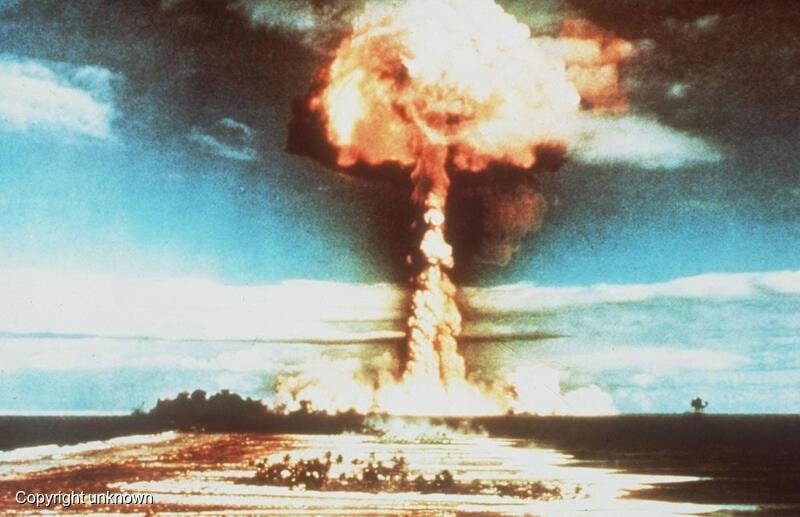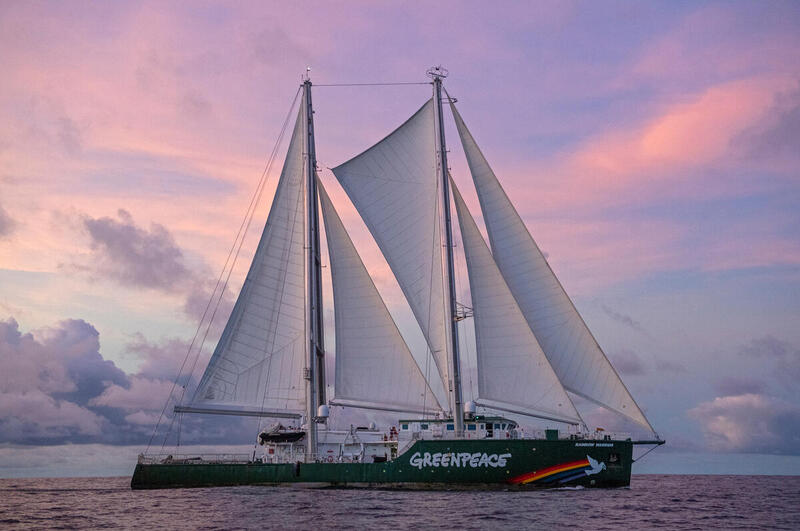Fifty years ago, on September 15th 1971, a ship named the Greenpeace set out to confront and stop US nuclear weapons testing at Amchitka, one of Aleutian Islands in southwest Alaska.
The crew of twelve never made it to Amchitka, but so contagious was the courage of their action, so compelling was their story of peace and ecology, and so audacious was their mission to confront a nuclear super-power that it sparked a movement.
The US ended nuclear testing at Amchitka the next year and Greenpeace grew into an organisation that is now a major part of a global movement. With a presence in over 55 countries, and a fierce independence made possible by tens of millions of volunteers, donors, and supporters, Greenpeace remains a formidable force.
For 50 years Greenpeace has fought and won countless campaigns. We have stood alongside communities, Indigenous people, and allies on the frontlines around the world in the fight to ensure a just, green and peaceful future. We’ve shown that when we stand together, we can win.
Alongside our allies we put an end to nuclear testing and the dumping of toxic waste at sea. We established a base in Antarctica and won a 50-year protection for the continent. We stopped offshore oil and gas exploration in Aotearoa, and we put an end to driftnet fishing on the high seas. Our investigation and confrontation of polluting corporations has been relentless, and time after time we’ve held them to account. Year after year, we have put our bodies on the line, between whales and the whalers’ harpoons, in front of oil the giant ships of the oil industry and in protection of the world’s rainforests.
Still, there’s more to be done. That same exploitation and destruction of nature which sparked the very first Greenpeace voyage, continues to worsen and we now find ourselves at a tipping point.
Greenpeace works to preserve our natural environment, to reduce our global emissions in order to prevent the most catastrophic impacts of climate change, to transform systems that affect our food production, to protect global oceans, to restore ancient forests that are key to biodiversity, and to seek climate justice on behalf of vulnerable communities already impacted by the ongoing climate emergency.
Greenpeace International Executive Director, Jennifer Morgan said:
“As we mark 50 years since the first Greenpeace voyage, biodiversity loss is accelerating, the climate emergency is deepening and inequality is growing.
“Over the last five decades there have been many campaigns and victories to demand a green, peaceful, and just future. Greenpeace continues to work as part of a global movement for system change to ensure that people and planet are put before profit and pollution.
“Greenpeace’s story is one of hope in action. It’s a story of people-power, of ordinary people doing extraordinary things. It’s a 50 year story which demonstrates that together we can force radical change, we can do what at first might seem impossible.
“Now, more than ever, we need to stand together in defence of nature, which nurtures and sustains us. We need to stand for equity, on which we build a lasting peace. We need to take back our shared future. The millions must become billions before it’s too late.”
A long history in Aotearoa
The loose network that formed around the first protest voyages that sailed from Aotearoa to protest the French Government’s nuclear tests at Moruroa Atoll in the early 1970s led to the founding of ‘Greenpeace New Zealand’ as an incorporated society in 1974, one of the first national Greenpeace offices to be established in the world.
Now known as Greenpeace Aotearoa, the organisation and its flagship SV Rainbow Warrior have had a huge impact over the years here in Aotearoa New Zealand, and achieved a long list of significant wins for people and planet, says current Executive Director, Russel Norman.
“From being the launching point for the successful international campaign to protect Antarctica, and having a central role in the campaigns to stop French nuclear testing, driftnet fishing, whaling and toxic pollution, through to eliminating single-use plastic bags and Government funded irrigation schemes, and establishing the Ross Sea Ocean Sanctuary, Greenpeace has been pivotal in a string of successful campaigns spanning 5 decades.
“One of the most significant of recent times has been the successful campaign to end offshore oil and gas exploration here in Aotearoa, and alongside iwi, hapū and many others, Greenpeace played a key role in that.
“Our main focus now is shifting the dominant agricultural model here in New Zealand away from intensive dairying to regenerative organic farming. Agribusiness is to New Zealand what coal is to Australia, or the tar sands are to Canada, in terms of pollution. We need healthy farms for healthy land, healthy water and a healthy climate,” says Norman.
Greenpeace Aotearoa is also running campaigns aimed at stopping seabed mining here and in the Pacific, protecting ocean biodiversity from industrial fishing, and eliminating unnecessary single-use plastics.
In conjunction with the 50th anniversary, Greenpeace Aotearoa has released an updated history of Greenpeace in New Zealand. Making Waves II is written by author and former Greenpeace Campaign Manager Michael Szabo, and continues the story from the original Making Waves book written by him and published in 1991.
It is intended to be an online educational resource that is relevant to the social studies curriculum, and the new NZ curriculum which comes into effect next year.
This article is a guest post and doesn’t necessarily represent the views of Greenpeace.




